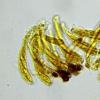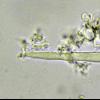
20-12-2025 23:08
Patrice TANCHAUDBonsoir, récolte sur sol sablonneux dans l'arri�

20-12-2025 15:47
Mirek GrycHi.These grew on pine wood that was heavily covere

18-12-2025 21:17
Pol DebaenstThe identification took me to Byssonectria deformi

15-12-2025 07:09
 Danny Newman
Danny Newman
indet. Rutstroemiaceae sp. on unk. fallen leavesMc

19-12-2025 10:10
Patrice TANCHAUDBonjour, récolte réalisée en milieu dunaire, a

18-12-2025 17:23
 Bruno Coué
Bruno Coué
Bonjour,je serais heureux d'avoir votre avis sur c

18-12-2025 18:07
Margot en Geert VullingsThese plumes were found on rotten wood.They strong

17-12-2025 18:35
 Michel Hairaud
Michel Hairaud
Bonjour à tous/Hi to everyone I am passing along
En la misma hoja de Quercus ilex
Illescas Tomás,
22-05-2016 20:25
 Buenas tardes a todos:
Buenas tardes a todos:En la misma hoja de Quercus ilex de mi consulta anterior (8-5-2016, Cazorla, Andalucía, España, a 1100 m snm.) he encontrado estos curiosos ascomas semejantes a diminutas Cheilymenia (diametro de los ascomas 110-175 µm), que no me suenan a nada que conozca.
Poseen pelos marginales agudos, engrosados en la base y con ligeras incrustaciones en la parte apical, de 35-90 x 3-6 µm. Ascas bitunicadas, tetraspóricas, IKI +, de 35-45 x 6,5-9,5 µm.
Esporas lisas, cilíndrico-fusiformes, algo alantoides, de 11,5-16 x 2,75-4,5, con algunas gútulas.
Paráfisis cilíndricas, con el ápice muy engrosado (hasta 5 µm) y presentando en la parte superior abundante pigmento intracelular de color pardo al ser observado en agua, fuertemente dextrinoide en IKI.
Gracias por vuestra ayuda. Un saludo,
Tomás Illescas
Hans-Otto Baral,
22-05-2016 20:41

Re : En la misma hoja de Quercus ilex
I suppose you collected this longer ago, since only the spores are alive. The contents in the paraphyses were probably bright yellow when fresh. It is a Calycellina, perhaps related to the 4-spored C. lachnobrachya.
Salvador Tello collected a very similar fungus on Q. ilex leaves in 2014: apothecia bright yellow, spores (11-) 12 - 15 (-15,7) x (2,6-) 2,9 - 4,6 (-5,8) µm, but asci 8-spored, and hairs perhaps not roughened.
I feel in Calycellina many unknown taxa can still be discovered. Would be good to recolect this and document in the living state.
The hairs reminded me of Hyalopeziza pygmaea but that species has no refractive yellow vacuolar contents.
Salvador Tello collected a very similar fungus on Q. ilex leaves in 2014: apothecia bright yellow, spores (11-) 12 - 15 (-15,7) x (2,6-) 2,9 - 4,6 (-5,8) µm, but asci 8-spored, and hairs perhaps not roughened.
I feel in Calycellina many unknown taxa can still be discovered. Would be good to recolect this and document in the living state.
The hairs reminded me of Hyalopeziza pygmaea but that species has no refractive yellow vacuolar contents.
Illescas Tomás,
22-05-2016 21:38

Re : En la misma hoja de Quercus ilex
Muchas gracias, Zotto.
El examen microscópico lo hice al cabo de una semana de su recolección, pero hasta ahora no he tenido tiempo de realizar esta consulta. Aunque intenté conservar la muestra en las mejores condiciones posibles, puede que sufriera durante el viaje debido al calor.
Preguntaré a Salvador por su recolecta, pues no la recuerdo. Estaré atento por si vuelvo a recolectarla.
Efectivamente, los pelos poseen contenido refringente en su base.
Un saludo,
Tomás Illescas
El examen microscópico lo hice al cabo de una semana de su recolección, pero hasta ahora no he tenido tiempo de realizar esta consulta. Aunque intenté conservar la muestra en las mejores condiciones posibles, puede que sufriera durante el viaje debido al calor.
Preguntaré a Salvador por su recolecta, pues no la recuerdo. Estaré atento por si vuelvo a recolectarla.
Efectivamente, los pelos poseen contenido refringente en su base.
Un saludo,
Tomás Illescas
Hans-Otto Baral,
22-05-2016 22:10

Re : En la misma hoja de Quercus ilex
Here is the link:
http://www.ascofrance.fr/search_forum/28629
Your last photo is great! It shows how thick-walled the hairs are, with a lumen only at the base. I never saw a fungus with yellow VB-vacuoles and thick-walled hairs.
http://www.ascofrance.fr/search_forum/28629
Your last photo is great! It shows how thick-walled the hairs are, with a lumen only at the base. I never saw a fungus with yellow VB-vacuoles and thick-walled hairs.
Illescas Tomás,
22-05-2016 23:08

Re : En la misma hoja de Quercus ilex
La especie recolectada por Salvador realmente es muy similar, aunque microscópicamente tanto la morfología de los pelos como de las esporas (septadas!) difieren bastante.
También veo próxima alguna otra especie octospórica como Hyalopeziza raripila.
Un saludo,
Tomás Illescas
También veo próxima alguna otra especie octospórica como Hyalopeziza raripila.
Un saludo,
Tomás Illescas
Hans-Otto Baral,
23-05-2016 09:59

Re : En la misma hoja de Quercus ilex
Yes, but also H. raripila has never these distinct contents (VBs) of the paraphyses. Therefore it would be very comfortable to make photos of lving paraphyses and hairs of your fungus, this would be better convincing. Presence of VBs appears to be a character at the family level.




